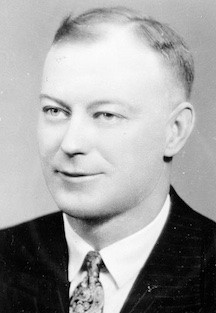The CCF, George Hara Williams, and Saskatchewan’s socialist movement
_1400_787_90_s_c1.jpg)
Of all the notable people in Saskatchewan’s history, former premier and MP Tommy Douglas is perhaps the figure who looms largest in both the individual and collective consciousness. Literally nicknamed “the Prairie Giant,” Douglas is known best for his role in the creation of medicare – North America’s first universal, single-payer health-care system – and for his work as leader of the Co-operative Commonwealth Federation (CCF), later renamed the New Democratic Party of Canada. He was even voted “the Greatest Canadian” by CBC viewers in 2004.
But this isn’t a book about Tommy Douglas. While Douglas is almost universally known in Canada, the same cannot be said for his political contemporary, George Hara Williams. Despite being the leader of the Saskatchewan CCF and a key player in the political organization and activation of the province’s farmers, few people outside the world of political and labour history have heard of Williams or his contributions to Saskatchewan’s political landscape. J.F. Conway attempts to remedy this in his 2018 book The Prairie Populist: George Hara Williams and the Untold Story of the CCF.
Before we dive into Conway’s book, let’s first learn more about George Hara Williams. Williams was born in 1894 in Binscarth, Manitoba. His family lived briefly in Sintaluta, Saskatchewan, before settling in Winnipeg. After serving in the First World War, Williams briefly attended the Manitoba Agricultural College, eventually accepting a job as the livestock and equipment director for the Soldier Settlement Board in Saskatchewan. In 1921, Williams became a working farmer, settling near Semans. He soon became involved in the organized farmers’ movements that were developing at the time. Between 1921 and 1931, Williams was active with both the National Farmers Union and the United Farmers of Canada.
Farmers occupied a social class that was neither fully capitalist nor fully working class, accounting for the wide variety of political affiliations with which they aligned themselves.
In 1932, Williams would co-chair the convention that would unite Canadian farmers and the Independent Labour Party, forming the political party that became the CCF in 1934. He was also elected to the Saskatchewan legislature in 1934, representing the constituency of Wadena, and became party president and leader of the CCF’s Saskatchewan branch in 1936, a role he continued to hold until 1941, when he was replaced by Douglas. Douglas’s victory over Williams occurred while Williams was once again serving overseas in the military, this time during the Second World War. Williams was discharged from active service in 1944, just in time for the 1944 provincial election, where he was once again elected to the legislature. Williams was appointed minister of agriculture under the Douglas government but was forced to resign after only a few months due to health issues. Williams died on September 12, 1945, at the age of 50.
George Hara Williams. Photo courtesy of Wikicommons
Conway is telling two stories in The Prairie Populist: the story of Williams as an individual and the story of the role of farmers in the founding and eventual victory of the CCF in Saskatchewan. Throughout the book, it becomes clear that both stories are of equal importance to Saskatchewan’s history and are treated as such by Conway. Conway draws upon a number of different sources for his book, including an unpublished biography of Williams written by his daughter, Muriel Wiens.
Williams was a complex man of many contradictions. He was a radical agrarian populist and a socialist, yet […] he was an enthusiastic supporter of the monarchy. He held an unassailable belief in British parliamentary democracy.
In terms of the first story, Conway paints a portrait of a compelling and complex individual. As adamant as he is that his book is not a straightforward biography, he is equally clear that it is not a hagiography and Williams is no socialist saint. Instead, Conway has sought to depict Williams as accurately as possible, even if it makes him harder to understand.
So what kind of person was Williams? According to Conway: “Williams was a complex man of many contradictions. He was a radical agrarian populist and a socialist, yet […] he was an enthusiastic supporter of the monarchy. He held an unassailable belief in British parliamentary democracy. His visit to the Soviet Union deepened his commitment to socialism […] but that visit also deepened his commitment to the democratic road to socialism.” Depictions of Williams’s personal life are equally contradictory; he is described by Conway as a devoted father and by his children as “less a parent than a deity.” In terms of the second story, Conway’s book also provides valuable background on the unique role that farmers played in the formation of the CCF and in Saskatchewan’s labour movement as a whole. Farmers occupied a social class that was neither fully capitalist nor fully working class, accounting for the wide variety of political affiliations with which they aligned themselves. This class-focused reading of Saskatchewan’s political and agricultural history is missing from many accounts of our province’s politics and Conway’s analysis helps explain why certain things in contemporary Saskatchewan politics “are the way they are,” so to speak.
The volume and thoroughness of Conway’s background research is one of The Prairie Populist’s biggest strengths but also its greatest weakness. While Conway’s prose is fairly readable for an academic book, at times it lacks a strong narrative voice that would make for a more engrossing read. The personal side to Williams’s story is sometimes bogged down by the CCF’s more political science–heavy history, which may be enough to prevent this book from being accessible to everyone. It might not be a beach read, but if you’re looking for a well-researched and compelling account of some lesser-known Saskatchewan history, The Prairie Populist is the book for you.
